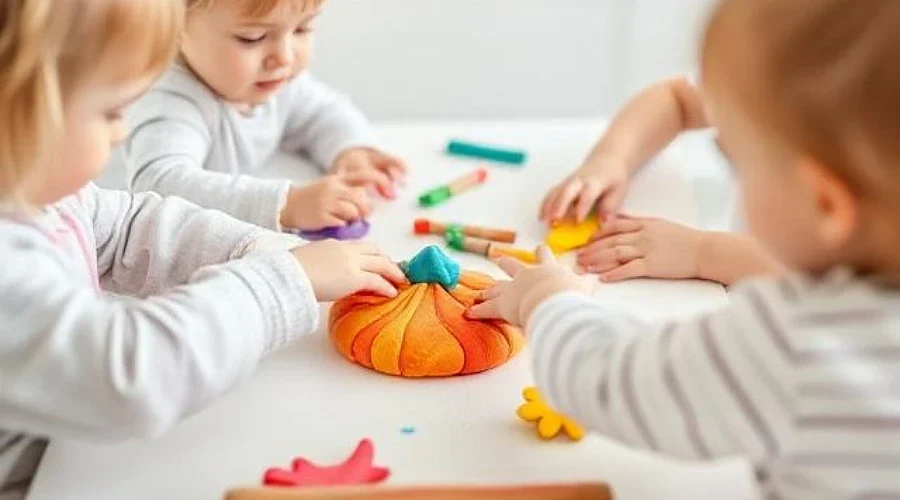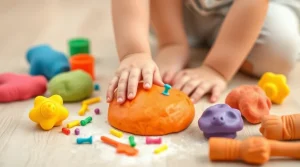
What Is Sensory Education in Montessori?
A complete guide to Montessori sensory education—how it refines perception, builds focus, and supports early development.
#1 Toys Manufacturer in China. WhatsApp: +86 180-0088-4063. Email: [email protected]
#1 Toys Manufacturer in China. WhatsApp: +86 180-0088-4063. Email: [email protected]

In 2025, sensory toys like Playdough and Kinetic Sand are taking the toy market by storm. These toys, which engage kids through tactile experiences, have become a must-have in many households. Their growing popularity reflects a broader shift in the industry, where parents and educators are increasingly prioritizing educational, eco-friendly, and hands-on toys.
With consumer preferences shifting towards sustainability and learning-based play, companies need to adapt quickly to stay relevant. Playdough and Kinetic Sand are no longer just toys—they’re essential tools for fostering creativity and problem-solving in a fun and environmentally-conscious way.
Sensory play is revolutionizing how children interact with toys. This approach encourages exploration using the senses—sight, sound, touch, taste, and smell. Playdough and Kinetic Sand are among the leading examples of toys that fit this trend.
Sensory play refers to activities that stimulate a child’s senses, especially touch. It’s not just fun; it’s essential for early childhood development. When children play with Playdough or Kinetic Sand, they practice motor skills like squishing, rolling, and shaping. These actions strengthen their hand muscles and coordination, which are crucial for tasks like writing or using utensils.
At the same time, sensory play encourages creativity, allowing children to build their own ideas and solve problems. It’s a hands-on way to learn, making abstract concepts more tangible. According to experts, sensory activities also help regulate emotions and reduce stress, giving kids a tool to calm down.
Playdough has long been a staple in the world of sensory toys. Originally invented in the 1950s, it started as a cleaning product but quickly became a favorite for creative play. Over the years, it has evolved into an educational tool for teachers and parents alike. Today, Playdough remains a simple yet powerful way to engage children in tactile exploration. Kids can squish, roll, cut, and mold the dough, learning about shapes, colors, and textures.
The beauty of Playdough lies in its versatility. It’s inexpensive, easy to clean, and most importantly, it lets children express their creativity without rules. Whether it’s making a cake or constructing abstract art, Playdough allows them to explore new ideas freely. As it becomes more eco-friendly with non-toxic materials, its popularity continues to rise among parents who are looking for safe, sustainable toys.
Kinetic Sand brings a new level of excitement to sensory play. Unlike traditional sand, it sticks together, allowing children to mold it into shapes that hold their form. This unique texture offers a captivating tactile experience, one that feels like magic. When children run their fingers through it, they experience smooth, flowing sensations that trigger their sense of touch in ways that other materials can’t.
The appeal of Kinetic Sand goes beyond just its texture. Its malleability makes it perfect for hands-on play, encouraging fine motor skills and focus. Kids can squeeze, flatten, or pour it into molds, sparking their imagination as they create landscapes or figures. The sensation of holding Kinetic Sand also helps children develop sensory awareness, which is key for their emotional and cognitive growth.
As a relatively new addition to the sensory toy market, Kinetic Sand is becoming a favorite for parents and teachers who are looking for innovative ways to engage children.
The popularity of Playdough and Kinetic Sand in 2025 is not just a passing trend. These sensory toys are gaining traction due to a variety of shifting market dynamics.
One of the main drivers of the popularity of Playdough and Kinetic Sand is the increasing demand for toys that offer educational and therapeutic benefits. Parents and educators are looking for toys that can enhance children’s development, particularly in the areas of fine motor skills and emotional well-being.
Both Playdough and Kinetic Sand are perfect examples of toys that fulfill these needs.
Playdough helps kids improve hand-eye coordination as they mold, shape, and squish it. Similarly, Kinetic Sand offers a therapeutic experience as kids use their hands to sift, squeeze, and mold the sand.
These activities help with fine motor skills, which are essential for other developmental milestones such as writing. Moreover, the calming, repetitive nature of playing with Kinetic Sand and Playdough provides stress relief for both children and adults. The demand for these types of sensory toys is growing, as they provide a holistic experience that combines learning with relaxation.
Sustainability is no longer just a buzzword—it’s a key factor influencing consumer behavior, especially in the toy industry. Parents are increasingly choosing eco-friendly products, and Playdough and Kinetic Sand are no exception. The shift toward non-toxic and environmentally friendly materials is driving the production of more sustainable versions of these sensory toys.
Many brands are now offering Playdough made from organic ingredients and non-toxic materials, ensuring safety while being environmentally conscious.
Kinetic Sand is also becoming more eco-friendly, with several companies focusing on using sustainable manufacturing processes. This demand for eco-friendly toys is not only driven by a concern for the planet but also by the desire to ensure that children are playing with safe and non-harmful materials.
In response, manufacturers are evolving to meet the demand, making sure their products align with the values of today’s consumers.
>> How Is Playdough Made? Exploring the Key Ingredients
Another trend shaping the toy market in 2025 is the increasing demand for customization and personalization. Consumers are now looking for toys that reflect their child’s individual preferences, from the color of Playdough to the type of Kinetic Sand.
Customizable Playdough, for instance, allows kids to create their own colors, enhancing the sense of ownership and creativity in play. Personalized sensory toys are becoming more popular, especially as parents seek out unique gifts or products for their children.
In addition to customizable colors, there is also a rise in personalized packaging. Parents can now find Playdough and Kinetic Sand sets that come in packaging tailored to the child’s name or favorite characters. This personal touch makes the toys feel special and unique, adding value beyond the product itself.
As manufacturers catch on to this trend, they are offering a wider range of personalization options, helping them stand out in a competitive market.
As children grow, their developmental milestones are shaped by the experiences they encounter. In 2025, the popularity of sensory toys like Playdough and Kinetic Sand highlights their significant role in early childhood development.
Playdough has been a staple in early childhood education for decades. It’s not only a fun, hands-on activity but also an effective tool for teaching foundational concepts. Children can use Playdough to learn shapes, colors, letters, and numbers in a way that feels natural and engaging. By rolling, squishing, and cutting the dough, children physically interact with the concepts they are learning.
For example, teachers can guide kids to mold shapes like squares, triangles, or circles, helping with shape recognition. As they mix different colored playdough, they also learn about colors. Additionally, Playdough can be used to form numbers and letters, providing a multisensory experience that enhances early literacy and numeracy skills.
Kinetic Sand introduces a whole new dimension to creative play. Unlike traditional sand, it sticks together, allowing children to shape and mold it into anything they imagine. This tactile quality helps kids exercise their creativity as they experiment with forming structures, textures, and shapes.
Kinetic Sand also encourages problem-solving skills. Whether they are figuring out how to create a stable sandcastle or solving how to make intricate designs, children engage in trial-and-error processes that strengthen critical thinking.
Both Playdough and Kinetic Sand provide unique sensory benefits that contribute to sensory development. The act of manipulating Playdough engages multiple senses: children feel the texture, smell the scent, and see the colors. This sensory input helps with sensory processing, allowing kids to better understand their environment and their own reactions to it.
Kinetic Sand, on the other hand, offers a soothing tactile experience. The grains of sand move smoothly through a child’s fingers, creating a calming effect.
For children with sensory sensitivities or stress, this tactile play can be therapeutic. The flow of the sand through their hands serves as a grounding exercise, helping to reduce anxiety and improve focus.
Sensory toys like Playdough and Kinetic Sand are also beneficial for children with special needs, offering a way to engage with the world in a way that feels safe and enjoyable.
As we move into 2025, consumer preferences and trends are shaping the toy industry in new and exciting ways.
In 2025, packaging and branding for Playdough and Kinetic Sand are becoming more family-centric and eco-conscious.
The messaging emphasizes both the fun and the educational value of these toys, reinforcing the idea that Playdough and Kinetic Sand are more than just playthings—they’re tools for learning and development.
As the family-friendly trend grows, brands are shifting their focus to communicate these values more effectively, ensuring their products stand out in a crowded market.
>> Is Kinetic Sand Messy? Debunking Common Myths About This Toy
The rise of e-commerce has significantly boosted the sales of Playdough and Kinetic Sand. Parents and caregivers are increasingly turning to online stores to buy toys, attracted by the convenience and variety available.
Online retailers have capitalized on this trend by offering detailed product descriptions, videos, and customer reviews, helping parents make informed decisions about the best sensory toys for their children.
Digital marketing plays a crucial role in driving sales for these toys. With social media ads, email marketing, and targeted online campaigns, toy brands can reach a wider audience than ever before.
Additionally, the ability to offer bulk orders, subscriptions, or customizable options through e-commerce platforms has made it easier for consumers to get exactly what they need. The growth of e-commerce in the toy industry shows no signs of slowing down, and Playdough and Kinetic Sand are at the forefront of this shift.
Social media and influencers are now essential in shaping toy trends, and Playdough and Kinetic Sand are no exceptions.
Videos of kids (and even adults) playing with Kinetic Sand or molding Playdough into intricate shapes capture the attention of viewers, making these toys seem like must-have items.
Their posts often go viral, leading to spikes in searches and sales.
As a result, toy brands are increasingly partnering with influencers to promote their products. These partnerships not only drive awareness but also build trust with consumers, as parents are more likely to purchase toys recommended by familiar faces online.
The combination of influencer marketing and social media has revolutionized the way toys are marketed, and Playdough and Kinetic Sand are riding this wave of digital influence.
As we look toward 2025, the Playdough and Kinetic Sand market is poised for even more exciting developments. From innovative new products to advances in sustainability, several trends are set to shape the future of these sensory toys.
In 2025, the Playdough and Kinetic Sand market will see a surge in product innovations. Brands are experimenting with new textures and materials to make these toys more engaging for children.
Playdough could come in smoother or more pliable forms, with textures that mimic real-world substances, like sand or clay. Similarly, Kinetic Sand might evolve to include more tactile variations, such as softer or more moldable versions that feel like foam or jelly.
Bright neon hues and even pastel versions of Playdough are becoming more popular, catering to different aesthetics. For Kinetic Sand, scents that match the colors, such as fruity or tropical fragrances, could add an extra layer of sensory stimulation. These innovations will not only keep the toys fresh and exciting but also engage kids in new ways, encouraging extended play.
Sensory toys like Playdough and Kinetic Sand are becoming more integral to education and therapy.
In 2025, we can expect further advancements in how these toys are used to support learning and therapy. Educational tools that combine these sensory materials with digital features—such as apps that teach children numbers or letters while they mold shapes—may become more common.
Future toys could integrate sensory features that promote mindfulness, such as calming textures and visual effects that respond to touch. These innovations will make these toys not only enjoyable but also more effective in aiding children with special needs, offering targeted support for those with autism or sensory processing disorders.
Sustainability will be a key focus in the future of Playdough and Kinetic Sand production. In 2025, toy manufacturers are expected to prioritize ethical practices, from using eco-friendly materials to ensuring fair labor practices.
Manufacturers might explore alternatives that still offer the same satisfying texture but are less harmful to the planet. As consumers demand greater transparency, the toy industry will likely continue shifting towards more sustainable and ethical manufacturing methods, setting a new standard for toy production.
In 2025, Playdough and Kinetic Sand will continue to thrive as popular sensory toys, driven by innovations in product design, educational benefits, and sustainability. As these toys evolve, they will not only support children’s development but also meet the growing demand for eco-friendly and customizable options.
The rising popularity of Playdough and Kinetic Sand in 2025 can be attributed to their versatility in promoting creativity, education, and sensory development. As parents and educators seek engaging, non-digital toys for kids, these materials offer a hands-on experience that fosters learning and calmness.
In 2025, we’re seeing exciting trends like scented Playdough, glow-in-the-dark Kinetic Sand, and new color-shifting or texture-changing varieties. These innovations enhance the sensory play experience, making them even more appealing for children while continuing to support educational and therapeutic benefits.
As sustainability continues to grow in importance, both Playdough and Kinetic Sand brands are opting for non-toxic, eco-friendly materials. Parents and schools are increasingly choosing these greener alternatives, aligning with the broader trend toward environmental consciousness in the toy industry.
Playdough is becoming an essential tool in early childhood education. In 2025, it's used not just for creative play, but also for teaching shapes, letters, numbers, and fine motor skills. Its tactile nature helps children develop their cognitive and physical abilities in an engaging way.
Yes, Kinetic Sand's growth in 2025 is expected to continue, especially in educational settings. Its ability to promote sensory development, problem-solving, and creativity makes it a valuable tool for both therapy and early childhood learning, encouraging imaginative play and fine motor skills.
More Related...

A complete guide to Montessori sensory education—how it refines perception, builds focus, and supports early development.

Educational toys unlock creativity, problem-solving, and sensory skills—find out why they matter for every growing child.

From calming stress to building skills, see how sensory toys help children develop focus, creativity, and confidence through hands-on play.

What’s the best toy for child development? Learn how sensory toys shape young minds and bodies in early learning stages.

Our team will answer your inquiries within 48 hours.
Copyright © 2025 GuangDong AKIA Technology Co,. Ltd. All Rights Reserved